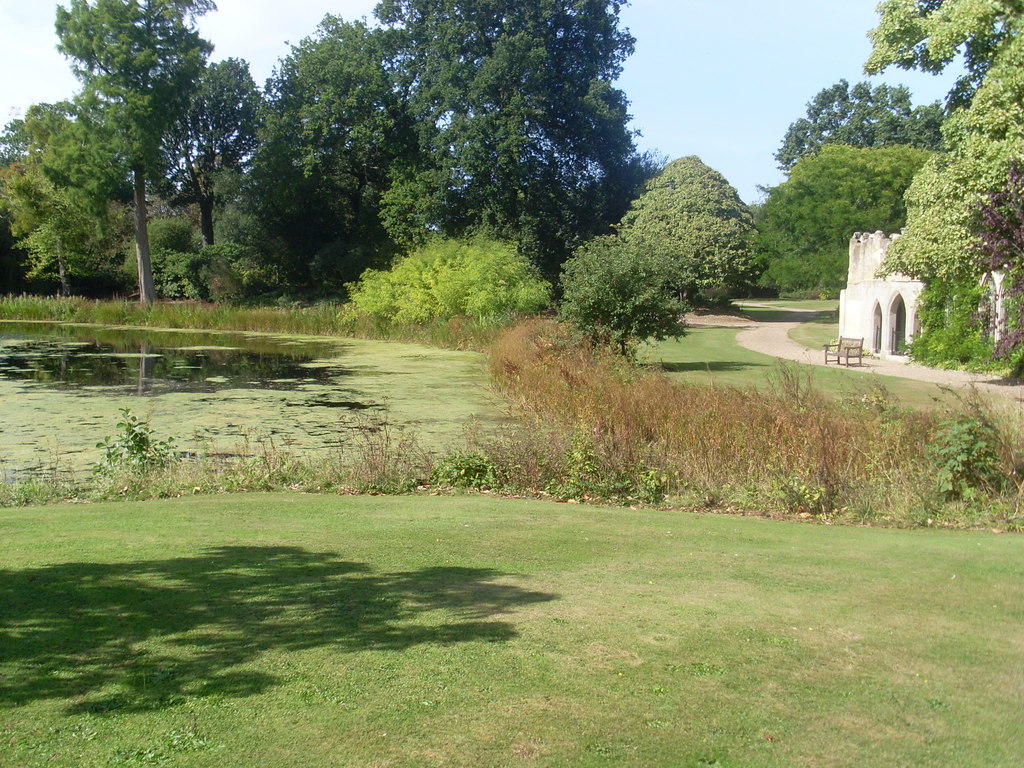In the northern end of the gardens at Frogmore is a small building, the so-called Gothic Ruin. We know that Queen Victoria used her brick and tiled Tea House in which to breakfast, write, sit and take tea. She often worked outdoors on her papers in a tent set up close to the Tea House. The gardens at Frogmore were of profound emotional importance to the Queen, not only for the peace and tranquillity that they afforded but because the grounds contained the mausoleums of both her mother, the Duchess of Kent and her beloved consort, Prince Albert.
Increasingly, the widowed Queen came to Frogmore to take tea and work, but also to sketch and paint. Another of these smaller buildings she used was the Gothic Ruin, close to Frogmore House and the Indian Kiosk gifted to her by Lord Canning after the Indian Mutiny.
The Gothic Ruin is the sole surviving garden feature that remains at Frogmore from the artistic partnership of the architect James Wyatt and George III’s daughter, Princess Elizabeth. Frogmore became a peaceful refuge for Queen Charlotte and her daughters, who used the grounds for recreation and ‘botanicking’; the artist Henry Edridge made engravings of the Queen, Princess Elizabeth and Princess Augusta in the gardens at Frogmore.
Appropriately for Princess Elizabeth, Edridge sketched her seated by the lake, with the Gothic Ruin in the background. Initially, there were further ornamental buildings at Frogmore at the time of Queen Charlotte. These included a hermitage, a barn (or, garden ballroom) which Princess Elizabeth designed and a Temple of Solitude, which stood on the site later occupied by the building initially conceived as a summer house for Queen Victoria’s mother, the Duchess of Kent but converted into a mausoleum on her death in 1861.
Princess Elizabeth designed the water pageant of Britannia at the Frogmore Fete for the King’s Jubilee in 1809, together with Wyatt. The Gothic Ruin was, therefore, a building adapted for Queen Victoria’s private use but unlike her Tea House, constructed during her grandfather’s reign and closely linked to her aunt, Princess Elizabeth, Landgravine of Hesse-Homburg. Significantly perhaps, engravings in the Royal Collection by the hand of Princess Elizabeth in exactly this period – the 1790s – depict various romantic views of ruins. George III – a remarkably gifted artist himself, particularly when it came to architecture – drew several views of a ruined temple in 1756
Queen Victoria remembered her aunts, George III’s daughters. The short memoirs which she wrote down in 1872 – surviving at Windsor – contain her recollections of these women, as seen through the eyes of a child.
She wrote of her aunt, Princess Augusta: ‘My Aunt, the Queen of Würtemberg [sic] (Princess Royal), came over, in the year ’26, I think, and I recollect perfectly well seeing her drive through the Park in the King’s carriage with red liveries and 4 horses, in a Cap [Queen’s italics] and evening dress, – my Aunt, her sister Princess Augusta, sitting opposite [Queen’s italics] to her, also in evening attire, having dined early with the Duke of Sussex at Kensington’.
This was that same Duke of Sussex who featured in her earliest memories of Kensington Palace, with the yellow carpet ‘and being told that if I cried and was naughty my ‘Uncle Sussex’ would hear me and punish me, for which reason I always screamed when I saw him!’.
The Duke of Sussex collected clocks and owned a remarkable library in his apartment at Kensington Palace, comprising of some 50,000 volumes. How different was the Queen’s recollection of her uncle, the Duke of York who gave her presents she found ‘beautiful’, and a donkey which she loved to ride as a child.

Research of the present revealed something of the Gothic Ruin interior. The outer corridor floor tiles were was decorated in a red and brown square pattern. The walls were painted in pale green, the windows fitted with stained glass depicting heraldic designs. The main room which the Queen would have used had an impressive marble fireplace surmounted by a gilded mirror and two female marble statuettes. The table at which the Queen presumably read and took tea was ornately decorated in red, gold and blue with a design of stars. There were a set of side chairs. The wall decorations bore the royal coat of arms, with the Tudor rose and the Queen’s crowned cypher beneath. A toothbrush dish that used to be in the Ruins at Frogmore survives in the Royal Collection, designed with a crowned Garter, the VR cypher and marked with the words’ WINDSOR CASTLE’.
The Ruin contained a Parian ware bust of Prince Albert, wearing his Garter Star and a bust of Albert Edward, Prince of Wales sculpted in 1864. The Gothic Ruin features in an album in the Royal Collection, of photographs collected by the Prince of Wales in the 1860s, at which time the Ruins were almost entirely covered in ivy.
Queen Victoria used the Gothic Ruin as a place in which to breakfast or read. She recorded visiting the Gothic Ruin in her journal for April 1868, where she took tea with her fourth daughter, Princess Louise. Fittingly, a bust of Princess Louise sculpted in 1871 – the year of her marriage to Lord Lorne – also previously stood in the Ruins.
The building has never been open to the public. It survives today in the gardens overlooking the lake at Frogmore, covered with wisteria and almost entirely obscured by trees.
©Elizabeth Jane Timms, 2020.

